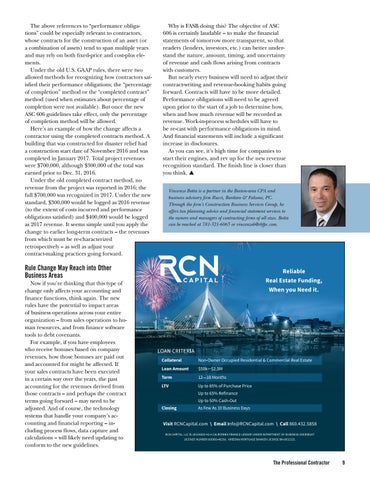The above references to “performance obligations” could be especially relevant to contractors, whose contracts for the construction of an asset (or a combination of assets) tend to span multiple years and may rely on both fixed-price and cost-plus elements. Under the old U.S. GAAP rules, there were two allowed methods for recognizing how contractors satisfied their performance obligations; the “percentage of completion” method or the “completed contract” method (used when estimates about percentage of completion were not available). But once the new ASC 606 guidelines take effect, only the percentage of completion method will be allowed. Here’s an example of how the change affects a contractor using the completed contracts method. A building that was constructed for disaster relief had a construction start date of November 2016 and was completed in January 2017. Total project revenues were $700,000, although $300,000 of the total was earned prior to Dec. 31, 2016. Under the old completed contract method, no revenue from the project was reported in 2016; the full $700,000 was recognized in 2017. Under the new standard, $300,000 would be logged as 2016 revenue (to the extent of costs incurred and performance obligations satisfied) and $400,000 would be logged as 2017 revenue. It seems simple until you apply the change to earlier long-term contracts – the revenues from which must be re-characterized retrospectively – as well as adjust your contract-making practices going forward.
Why is FASB doing this? The objective of ASC 606 is certainly laudable – to make the financial statements of tomorrow more transparent, so that readers (lenders, investors, etc.) can better understand the nature, amount, timing, and uncertainty of revenue and cash flows arising from contracts with customers. But nearly every business will need to adjust their contract-writing and revenue-booking habits going forward. Contracts will have to be more detailed. Performance obligations will need to be agreed upon prior to the start of a job to determine how, when and how much revenue will be recorded as revenue. Work-in-process schedules will have to be re-cast with performance obligations in mind. And financial statements will include a significant increase in disclosures. As you can see, it’s high time for companies to start their engines, and rev up for the new revenue recognition standard. The finish line is closer than you think. s Vincenzo Botta is a partner in the Boston-area CPA and business advisory firm Rucci, Bardaro & Falzone, PC. Through the firm’s Construction Business Services Group, he offers tax planning advice and financial statement services to the owners and managers of contracting firms of all sizes. Botta can be reached at 781-321-6065 or vincenzob@rbfpc.com.
Rule Change May Reach into Other Business Areas Now if you’re thinking that this type of change only affects your accounting and finance functions, think again. The new rules have the potential to impact areas of business operations across your entire organization – from sales operations to human resources, and from finance software tools to debt covenants. For example, if you have employees who receive bonuses based on company revenues, how those bonuses are paid out and accounted for might be affected. If your sales contracts have been executed in a certain way over the years, the past accounting for the revenues derived from those contracts – and perhaps the contract terms going forward – may need to be adjusted. And of course, the technology systems that handle your company’s accounting and financial reporting – including process flows, data capture and calculations – will likely need updating to conform to the new guidelines.
The Professional Contractor
9
